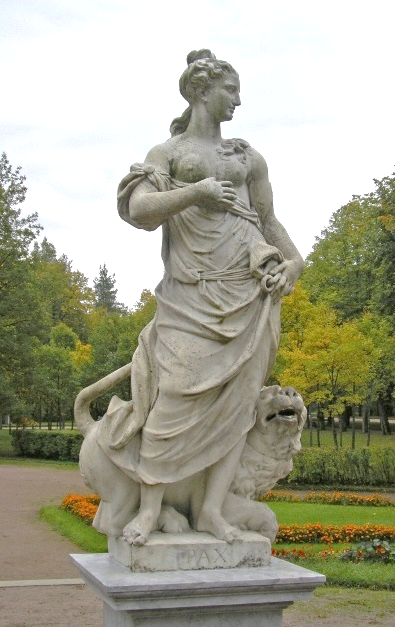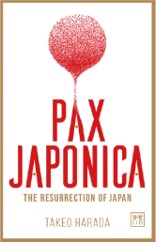What is the Ideal World Image of “Pax,” the Goddess of Peace?

The vision of our institute is “Pax Japonica,” and there is a book with the exact same title. Takeo Harada, founder and CEO of our institute, published the book “Pax Japonica -The Resurrection of Japan-” in English in 2017. I wonder if any of you have read it. We have given this book to students participating in our “Entrepreneurship Education (Information Literacy Education)” program. Because we think that the students, who will lead the future, should have a correct understanding of the history of our country, and a strong will to adjust our country to what it should be in the future.
For those who have been members of the “Takeo Harada Gemeinschaft,” our membership service for many years, it is probably unnecessary to explain what “Pax Japonica” stands for. However, since this is a social contribution project blog, I would like to share our vision of “Pax Japonica” with you once again.
First of all, “Pax” is a Latin word. In Roman mythology, Pax was the daughter of the Roman god Jupiter and the goddess Justice. Since she was the symbol of “peace,” “Pax” has been used as a word meaning “peace”.
(Photo: Statue of Pax, located in St. Petersburg)

(Reference: Wikipedia)
(While researching the Roman goddess Pax for this blog, I was surprised to learn that the Pax statue in the Pavlovsk Garden in St. Petersburg is well-known. Because our institute is associated with St. Petersburg State University of Economics.)
You have probably heard the word “Pax XXX” before. When I was a high school student, I learned the terms “Pax Romana” and “Pax Americana” in my world history class. The former term refers to the 200 years between the reign of Augustus at the end of the first century B.C. to the reign of the Five Good Emperors, as the Golden Age of ancient Rome. The latter is generally referred to the IMF = dollar system, the GATT system (a system of international agreements based on the General Agreement on Tariffs and Trade signed in 1947), and the global political-military system that emerged as the Cold War system.
“Pax Britannica” also refers to the period from 1815 (the Battle of Waterloo) to 1914 (the outbreak of World War I), when the British Empire had the dominant power on the world’s oceans, and world peace was relatively maintained by the “most powerful capitalist empire”. There is also a term called “Pax Tatarica,” which refers to a period of military security provided by the mobility of the Mongols, especially their cavalry. Assuming the meaning of the “Pax Japonica” from the meaning of those terms, the literal translation of “Pax Japonica” is “peace of Japan,” or in other words, “peace of the world leading by Japan”.
So the title of this book has the meaning above. Why don’t you want to know what it says?
(Image: The book, Pax Japonica)

(Reference: IISIA)
The table of contents of the book is as follows.
Preface
Chapter 1: The ‘Pulling-Character’ and ‘Passiveness’ of Japan
Chapter 2: Japan as a State of Failed Innovation
Chapter 3: The Truth of Japan’s Pacifism After 1945
Chapter 4: Resurrection of Japan’s Gold Warriors
Conclusion
The book begins as follows; “In memory of Shunsuke Kagawa, a Gold Warrior sacrificed for ‘Pax Japonica.’”
The book briefly describes a scenario in which the “Japan bubble” will return, followed by a “Japan default.” In addition, from the default Japan will be resurrected, and the era of “Pax Japonica” will arrive.
Chapter 1 focuses on the characteristics of Japanese people. In Chapter 2, it firstly describes the opinion of Ezra F. Vogel, who stated that Japan had been successful in economic, by using his book “Japan as Number One: Lessons for America” (1979). However, the author pointed out that the Japanese people in reality were only passively enduring pressure from foreign powers, and although they accumulated knowledge, they did not apply it to innovation. Chapter 3 discusses pacifism and shows the relationship between the Constitution and Pax Japonica, and Chapter 4 focuses on the “Gold Warriors: America’s Secret Recovery of Yamashita’s Gold” written by Sterling Seagrave and Peggy Seagrave. The author discusses the keys to the realization of Pax Japonica based on the movement of gold bullion, referring to the postwar claim that the gold bullion was used as a source of finance during the Cold War.
We believe that understanding the content of the book will deepen your understanding of the “Audio Daily/Weekly Report of Takeo Harada” and “IISIA Daily Report,” etc., the recommended products in the “Takeo Harada Gemeinschaft membership service” of our institute. If you are interested in those kinds of topics, we strongly recommend you to read the book “Pax Japonica”, and would like to hear your thoughts and opinions over our vision “Pax Japonica”.
※The statements in this blog are not the official views of the Institute, but rather the personal views of the author.
Chancellery Unit, Group for Project Pax Japonica, Maria Tanaka



